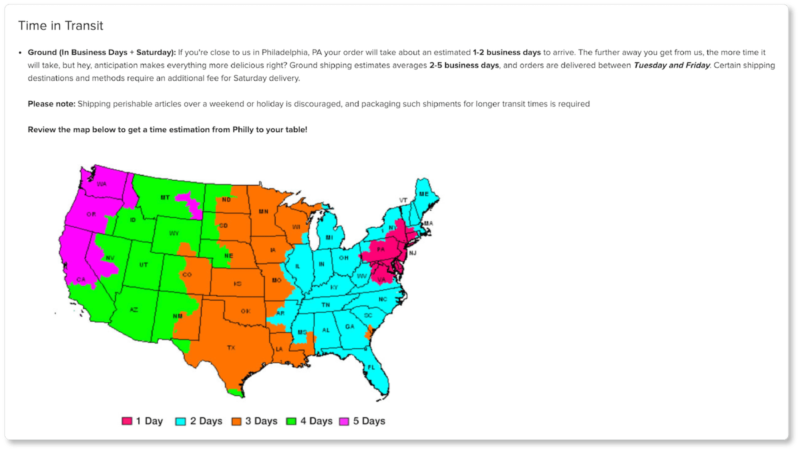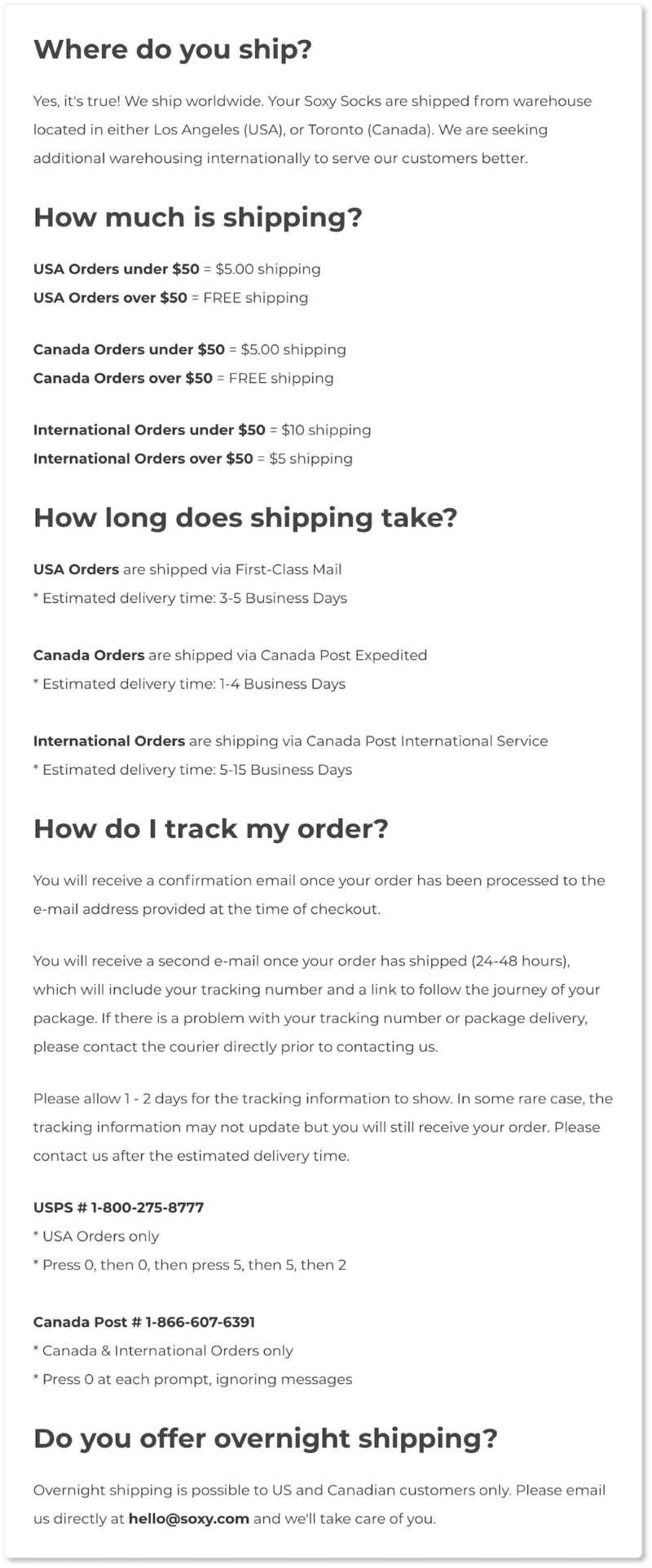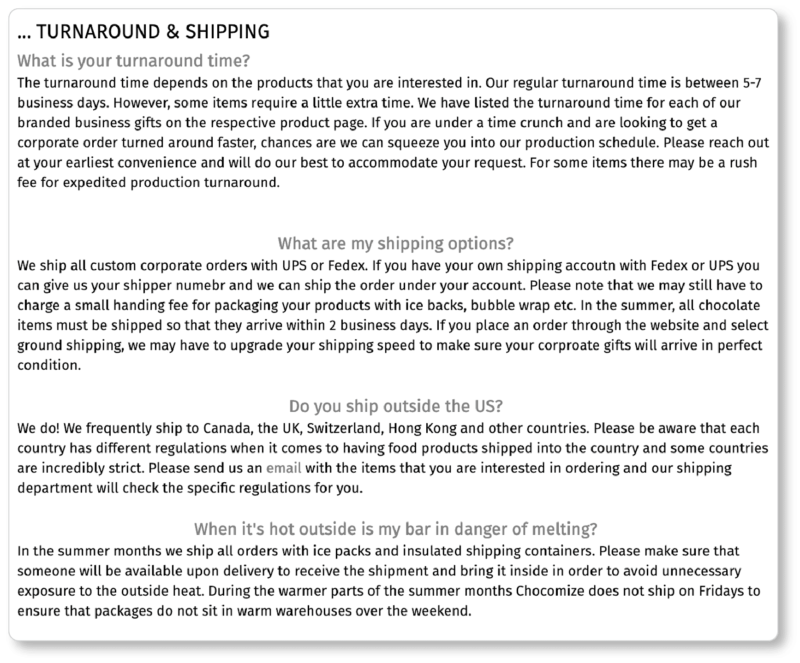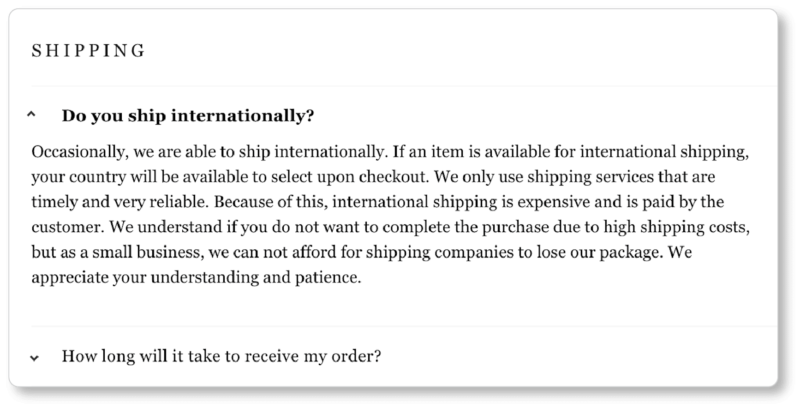- HOME
- Ecommerce
- Building Your Ecommerce Website
- Writing Your Best Ecommerce Shipping Policy
Writing Your Best Ecommerce Shipping Policy
- 6 Mins Read
- Posted on March 6, 2019
- Last Updated on October 8, 2024
- By Lauren
In the last two sections, we walked you through determining the best shipping prices and finding the best carriers for your ecommerce business. By now, you’re pretty clear about what your business’ shipping costs look like, what pricing strategy you’ll use to charge your customers for shipping, and what carrier/s work best for your products and locations.
But of course, it’s one thing to have these things in place, and another to be transparent with your customers about what they are.
A shipping policy is just what it sounds like: a document that describes available carriers, shipping methods, shipping restrictions, delivery costs, estimates for transit times… and answers every other question you can imagine prospects might have about how your products arrive at their respective front doors. (Put yourself in your customers’ shoes for those ones.)
Many ecommerce businesses combine their shipping policy with their Returns & Refunds policy—the document that describes the conditions under which returns and exchanges are permitted, and the steps customers will have to take to return an item. We discuss them as separate documents here because we think it’s good UX to distinguish them: They’re questions that will arise for prospects at around the same time in the buyer’s journey, yes; but they’re answering two very different sets of questions for two very different sets of circumstances. As such, answering them in separate documents makes it as easy as possible for site visitors to find what they’re looking for.
But to think about them together for a moment: Your shipping and returns policies will likely be among the most-read documents on your website. And you literally can’t afford to overlook them for both business and legal reasons. After all, no ecommerce business can ignore shipping if it plans on making sales. And if you’re selling online, there’s no dodging the “returns” question either: Around 30% of products ordered online are returned—over three times as many as are returned to brick-and-mortar stores. In other words, your shipping and Returns & Refunds policies describe strategies that are fundamental to your larger business strategy.
Formalizing policies and offering them on your website serves both your customers and your business. Customers will feel they’re being clearly communicated with, which means increased brand trust, fewer cart abandonments… and more sales. What’s more, written policies will ensure you treat all orders the same way, rather than on a case-by-case basis, which is typically more time-consuming and expensive—not to mention more frustrating for your employees.
Luckily, both policies can be short and simple.
What to Include in Your Shipping Policy
A good shipping policy will include the following information:
- Courier options. What shipping companies does your business use? Customers will want to know this for all sorts of reasons—not least among them personal preferences or histories with certain couriers.
- Service types. Do you offer same-day shipping? Express overnight? Or only standard shipping? Do you provide tracking information for all of your shipments, or only those that are shipped through specific couriers? If you have a brick-and-mortar location, do you offer in-store pickup? If so, within what timeframe? And so on.
- Transit times. This may (or may not!) be obvious for services such as same-day shipping, but what about standard or international shipping? Do you ship packages the same day customers order them? If so, until what time of day? If not, how long will it take you to send them off? Will certain items take longer to arrive than others? Offer an estimated range. We love this map from Di Bruno Bros.:

- Pricing. Do you offer free shipping, flat rates, real-time rates, or some combination of the three? If you offer free shipping, are there conditions (a minimum order value, for example) and/or exclusions? If you ship internationally, what duties and taxes might apply? Will you deliver the shipment with duties and taxes paid (DDP) or unpaid (DDU)?
- Restrictions. Are there places you can’t deliver to (PO boxes or military addresses, for example), won’t deliver to (internationally, for example), or countries in which your products are prohibited? Don’t make customers go through your entire checkout process only to discover that they can’t receive your product after all. (Indeed, for even better user experience, you might also note these restrictions on your homepage or product pages.)
…and anything else you think prospects and customers should know. Some of this will be determined by your product; some by your commerce platform. For example, if your platform doesn’t allow for automatic stock notifications, how soon after their order is placed will shoppers be notified if that item isn’t in stock after all? Regardless of your capacities, be up-front with customers about every detail of the process—from the moment they hit the “Purchase” CTA to the moment the package arrives at their door. Your mantra as you craft the policy should be: “No surprises.”
Examples of Strong Ecommerce Shipping Policies
It’s never a bad idea (read: It’s a great idea!) to take a look at the shipping policies of your competitors to get a sense of the industry standard. Here are two examples of strong shipping policies. The first is from the sock company Soxy, which offers a link to “Shipping & Delivery” in its website footer. (Note that Soxy has separated this policy from its “Returns & Refunds” policy):

Here’s what a visitor sees when they click into that link:

The company’s covered everything here—from shipping costs, to destination, to transit times, to tracking. It’s simultaneously short and comprehensive. Soxy also offers its policy in the form of an FAQ, so users can jump to precisely the question they have. What’s more, it’s written in a conversational tone—we actually felt like we were being spoken to as we read through it.
Another strong example is on the website of the chocolate company Chocomize… though they tuck their shipping details into their FAQ, which we wouldn’t necessarily recommend. (While there’s nothing wrong with discussing shipping in both places, remember, you’re an ecommerce store. Customers are going to have questions about shipping—and they don’t want to work to find the answers):
 You probably see why we’ve chosen Chocomize as an example—that final question. Remember, elements of your shipping policy will vary based on your product, your margins, your customers, and more. In Chocomize’s case, there’s a genuine concern that the product might melt during transit—a concern that needed to be addressed. So think beyond the standard questions. Are there concerns your prospects are likely to have about shipping your product/s? You might add to your policy once business gets going and you find yourself fielding the same questions about shipping. If more than one prospect asks about it, it may be worth addressing in your shipping policy.
You probably see why we’ve chosen Chocomize as an example—that final question. Remember, elements of your shipping policy will vary based on your product, your margins, your customers, and more. In Chocomize’s case, there’s a genuine concern that the product might melt during transit—a concern that needed to be addressed. So think beyond the standard questions. Are there concerns your prospects are likely to have about shipping your product/s? You might add to your policy once business gets going and you find yourself fielding the same questions about shipping. If more than one prospect asks about it, it may be worth addressing in your shipping policy.
Finally—as will be the case with your returns & refunds policy—choose honesty above silence. We love the forthrightness at Taft Clothing:

Taft is candid about the limitations of its ecommerce platform (users won’t know until checkout if an item will ship to their country) and their financial limitations as a small business. That last line is particularly endearing; and it makes us all the more willing to pay shipping costs to support their business.
All that’s to say, remember your business’ voice when you’re crafting this document. Be honest and personable. Just because it has the word “policy” in it doesn’t mean it needs to be drab, dull, or formal. Like everything on your website, it’s part of what makes up your brand. So answer the questions you need to answer… but beyou while answering them.
Of course, the other question prospects will have at this point in the checkout process is what your Returns & Refunds policy looks like. In the next section, we’ll tackle that document: why you want one, what to include in yours, and how to make your returns policy a conversion-booster. (Yes; it’s possible!)